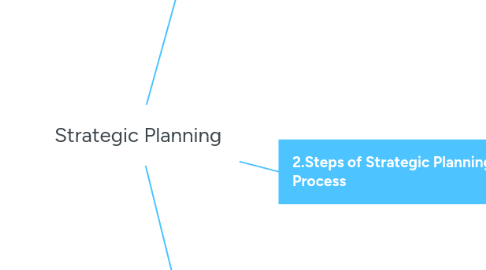
1. 1.The Antecedents of Strategic Planning Initiation
1.1. Management Characteristics
1.1.1. Long-term Orientation
1.1.2. Perception of past Success
1.2. Firm Dynamics
1.2.1. Competitor Orientation
1.2.2. Cultural Entrenchment
1.2.3. Resource Richness
1.2.4. Anti-planning Political Behavior
1.3. Environmental Factors
1.3.1. Competitive Intensity
1.3.2. Industry-wide Mindset
2. 2.Steps of Strategic Planning Process
2.1. Formulating Organization’s Mission
2.2. Goal Setting (Main and Specific)
2.3. Evaluation of Organizational Resources & Environmental Opportunities and Threats
2.3.1. SWOT
2.3.1.1. Strength
2.3.1.2. Weakness
2.3.1.3. Opportunity
2.3.1.4. Threat
2.4. Strategy Formulation
2.5. QSPM: Quantitative Strategic planning Matrix
2.5.1. Organizational structure appropriate to strategies
2.5.2. Coordination of organization’s skills, resources and capabilities in the executive level
2.5.3. Create an organizational culture appropriate to the organization's new strategy
2.5.4. Cooperation and sympathy among managers and employees of all sections and units of organization
2.6. Strategy Evaluation
2.6.1. main activities
2.6.1.1. Review of main principles of organization’s strategy
2.6.1.2. Compare expected results with actual results
2.6.1.3. Taking corrective actions to ensure the accuracy of performance and operating based on plans
2.6.2. criteria for strategy evaluation
2.6.2.1. Procedure stability
2.6.2.2. Compatibility with environmental factors
2.6.2.3. Feasibility
2.6.2.4. Having a competitive advantage
3. 3.The Relationship Between Flexibility, Strategic Planning and Organizational Performance
3.1. 3.The Relationship Between Flexibility, Strategic Planning and Organizational Performance
3.1.1. Operational Flexibility
3.1.1.1. Operational flexibility is organizational ability to rapidly adjust market offerings, product/service mix and production capacity
3.1.2. Financial Flexibility
3.1.2.1. Financial flexibility is organizational ability to rapidly gain access to, and deploy financial resources.
3.1.3. Structural Flexibility
3.1.3.1. Structural flexibility is organizational ability to rapidly restructure
3.1.4. Technological Flexibility
3.1.4.1. Technological flexibility is defined as organizational ability to alter technological capacity in line with competitive requirements
